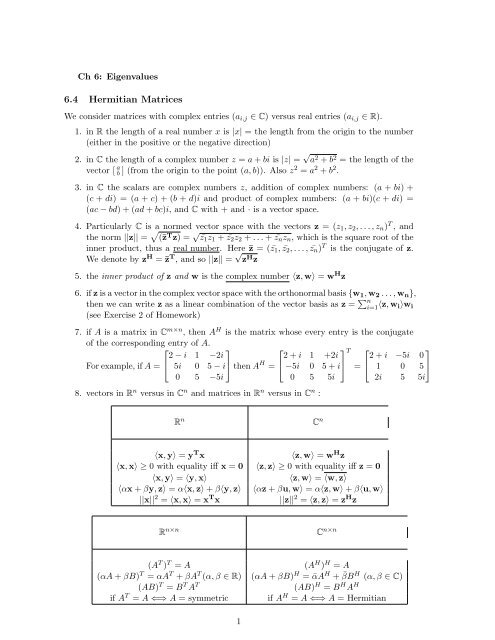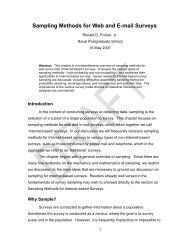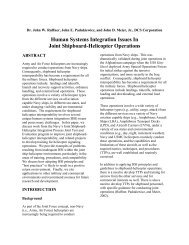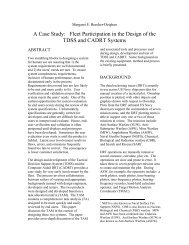6.4 Hermitian Matrices
6.4 Hermitian Matrices
6.4 Hermitian Matrices
You also want an ePaper? Increase the reach of your titles
YUMPU automatically turns print PDFs into web optimized ePapers that Google loves.
Ch 6: Eigenvalues<br />
<strong>6.4</strong> <strong>Hermitian</strong> <strong>Matrices</strong><br />
We consider matrices with complex entries (a i,j ∈ C) versus real entries (a i,j ∈ R).<br />
1. in R the length of a real number x is |x| = the length from the origin to the number<br />
(either in the positive or the negative direction)<br />
2. in C the length of a complex number z = a + bi is |z| = √ a 2 + b 2 = the length of the<br />
vector [ a b ] (from the origin to the point (a, b)). Also z 2 = a 2 + b 2 .<br />
3. in C the scalars are complex numbers z, addition of complex numbers: (a + bi) +<br />
(c + di) = (a + c) + (b + d)i and product of complex numbers: (a + bi)(c + di) =<br />
(ac − bd) + (ad + bc)i, and C with + and · is a vector space.<br />
4. Particularly C is a normed vector space with the vectors z = (z 1 , z 2 , . . . , z n ) T , and<br />
the norm ||z|| = √ (¯z T z) = √ ¯z 1 z 1 + ¯z 2 z 2 + . . . + z¯<br />
n z n , which is the square root of the<br />
inner product, thus a real number. Here ¯z = ( ¯z 1 , ¯z 2 , . . . , z¯<br />
n ) T is the conjugate of z.<br />
We denote by z H = ¯z T , and so ||z|| = √ z H z<br />
5. the inner product of z and w is the complex number 〈z, w〉 = w H z<br />
6. if z is a vector in the complex vector space with the orthonormal basis {w 1 , w 2 . . . , w n },<br />
then we can write z as a linear combination of the vector basis as z = ∑ n<br />
i=1 〈z, w i〉w i<br />
(see Exercise 2 of Homework)<br />
7. if A is a matrix in C m×n , then A H is the matrix whose every entry is the conjugate<br />
of the corresponding entry of A.<br />
⎡<br />
⎤<br />
⎡<br />
⎤T<br />
⎡<br />
⎤<br />
2 − i 1 −2i<br />
2 + i 1 +2i 2 + i −5i 0<br />
For example, if A = ⎣ 5i 0 5 − i⎦ then A H = ⎣ −5i 0 5 + i⎦<br />
= ⎣ 1 0 5 ⎦<br />
0 5 −5i<br />
0 5 5i 2i 5 5i<br />
8. vectors in R n versus in C n and matrices in R n versus in C n :<br />
R n<br />
C n<br />
〈x, y〉 = y T x<br />
〈z, w〉 = w H z<br />
〈x, x〉 ≥ 0 with equality iff x = 0 〈z, z〉 ≥ 0 with equality iff z = 0<br />
〈x, y〉 = 〈y, x〉 〈z, w〉 = 〈w, z〉<br />
〈αx + βy, z〉 = α〈x, z〉 + β〈y, z〉 〈αz + βu, w〉 = α〈z, w〉 + β〈u, w〉<br />
||x|| 2 = 〈x, x〉 = x T x<br />
||z|| 2 = 〈z, z〉 = z H z<br />
R n×n<br />
C n×n<br />
(A T ) T = A (A H ) H = A<br />
(αA + βB) T = αA T + βA T (α, β ∈ R) (αA + βB) H = ᾱA H + ¯βB H (α, β ∈ C)<br />
(AB) T = B T A T<br />
(AB) H = B H A H<br />
if A T = A ⇐⇒ A = symmetric if A H = A ⇐⇒ A = <strong>Hermitian</strong><br />
1
9. A matrix A is a <strong>Hermitian</strong> matrix if A H = A (they are ideal matrices in C since<br />
properties that one<br />
[<br />
would expect<br />
]<br />
for matrices will probably<br />
[<br />
hold).<br />
]<br />
1 2 − i<br />
1 2 + i<br />
For example A =<br />
is <strong>Hermitian</strong> since<br />
2 + i 0<br />
Ā = and so<br />
2 − i 0<br />
[ ]<br />
A H 1 2 − i<br />
= ĀT =<br />
= A<br />
2 + i 0<br />
10. if A is <strong>Hermitian</strong>, then[ A is symmetric. ] However the converse fails, and here is a<br />
1 2 − i<br />
counterexample: A =<br />
. However if A ∈ R<br />
2 − i 0<br />
n×n is symmetric, then it is<br />
<strong>Hermitian</strong>.<br />
Symmetric and orthogonal matrices in R n×n<br />
<strong>Hermitian</strong> and unitary matrices in C n×n<br />
Defn: if A T = A ⇐⇒ A = symmetric<br />
Defn: if A H = A ⇐⇒ A = <strong>Hermitian</strong><br />
A = symmetric =⇒ A is a square matrix<br />
A = <strong>Hermitian</strong> =⇒ A is a square matrix<br />
a pure complex matrix cannot be <strong>Hermitian</strong><br />
(the diagonal must have real entries)<br />
A = symmetric =⇒ λ i ∈ R, ∀i<br />
A = <strong>Hermitian</strong> =⇒ λ i ∈ R, ∀i<br />
A = symmetric =⇒ eigenvectors<br />
A = <strong>Hermitian</strong> =⇒ eigenvectors<br />
belonging to distinct eigenvalues are orthogonal belonging to distinct eigenvalues are orthogonal<br />
(see #5 page 353)<br />
Q is orthogonal if its column vectors<br />
U is unitary if its column vectors<br />
form an orthonormal set<br />
form an orthonormal set<br />
(i.e. Q T Q = I = QQ T ) (i.e. U H U = I = UU H )<br />
Q is orthogonal =⇒ Q −1 = Q T<br />
U is unitary =⇒ U −1 = U H<br />
if the eigenvalues of matrix A are all distinct, if A is an <strong>Hermitian</strong> matrix A,<br />
(or algebraic multipl λ i = geom multipl λ i , ∀i) =⇒ ∃U = unitary and it diagonalizes A<br />
=⇒ ∃X = nonsingular and it diagonalizes A (i.e. the diagonal matrix T is<br />
(i.e. the diagonal matrix D is T = U H AU or A = UT U H )<br />
D = X −1 AX or A = XDX −1 ) T is first shown to be upper triangular in Thm <strong>6.4</strong>.3<br />
(see Remark 3 page 308) and then that it is shown to be diagonal in Thm <strong>6.4</strong>.4<br />
11. These three give the last row in the table above:<br />
(a) if the eigenvalues of an <strong>Hermitian</strong> matrix A are all distinct, then ∃U that is<br />
unitary and it diagonalizes A. In this case U has as columns the normalized<br />
eigenvectors of A<br />
(b) Schur’s Theorem: If A is n × n, then ∃U a unitary matrix such that T = U H AU<br />
is upper triangular matrix.<br />
(c) Spectral Theorem: If A is <strong>Hermitian</strong>, then ∃U a unitary matrix such that U H AU<br />
is a diagonal matrix.<br />
Note that if some eigenvalue λ j has algebraic multiplicity ≥ 2, then the eigenvectors<br />
corresponding to λ j are not orthonormal, and so we use Gram-Schmidt<br />
to normalize them (we use Gram Schmidt for each set of eigenvectors that correspond<br />
to each repeated eigenvalue)<br />
2
R n<br />
C n<br />
〈x, y〉 = y T x<br />
〈z, w〉 = w H z<br />
〈x, x〉 ≥ 0 with equality iff x = 0 〈z, z〉 ≥ 0 with equality iff z = 0<br />
〈x, y〉 = 〈y, x〉 〈z, w〉 = 〈w, z〉<br />
〈αx + βy, z〉 = α〈x, z〉 + β〈y, z〉 〈αz + βu, w〉 = α〈z, w〉 + β〈u, w〉<br />
||x|| 2 = 〈x, x〉 = x T x<br />
||z|| 2 = 〈z, z〉 = z H z<br />
R n×n<br />
C n×n<br />
(A T ) T = A (A H ) H = A<br />
(αA + βB) T = αA T + βA T (α, β ∈ R) (αA + βB) H = ᾱA H + ¯βB H (α, β ∈ C)<br />
(AB) T = B T A T<br />
(AB) H = B H A H<br />
if A T = A ⇐⇒ A = symmetric if A H = A ⇐⇒ A = <strong>Hermitian</strong><br />
Symmetric and orthogonal matrices in R n×n<br />
<strong>Hermitian</strong> and unitary matrices in C n×n<br />
Defn: if A T = A ⇐⇒ A = symmetric<br />
Defn: if A H = A ⇐⇒ A = <strong>Hermitian</strong><br />
A = symmetric =⇒ A is a square matrix<br />
A = <strong>Hermitian</strong> =⇒ A is a square matrix<br />
a pure complex matrix cannot be <strong>Hermitian</strong><br />
(the diagonal must have real entries)<br />
A = symmetric =⇒ λ i ∈ R, ∀i<br />
A = <strong>Hermitian</strong> =⇒ λ i ∈ R, ∀i<br />
A = symmetric =⇒ eigenvectors<br />
A = <strong>Hermitian</strong> =⇒ eigenvectors<br />
belonging to distinct eigenvalues are orthogonal belonging to distinct eigenvalues are orthogonal<br />
(see #5 page 353)<br />
Q is orthogonal if its column vectors<br />
U is unitary if its column vectors<br />
form an orthonormal set<br />
form an orthonormal set<br />
(i.e. Q T Q = I = QQ T ) (i.e. U H U = I = UU H )<br />
Q is orthogonal =⇒ Q −1 = Q T<br />
U is unitary =⇒ U −1 = U H<br />
if the eigenvalues of matrix A are all distinct, if A is an <strong>Hermitian</strong> matrix A,<br />
(or algebraic multipl λ i = geom multipl λ i , ∀i) =⇒ ∃U = unitary and it diagonalizes A<br />
=⇒ ∃X = nonsingular and it diagonalizes A (i.e. the diagonal matrix T is<br />
(i.e. the diagonal matrix D is T = U H AU or A = UT U H )<br />
D = X −1 AX or A = XDX −1 ) T is first shown to be upper triangular in Thm <strong>6.4</strong>.3<br />
(see Remark 3 page 308) and then that it is shown to be diagonal in Thm <strong>6.4</strong>.4<br />
3












